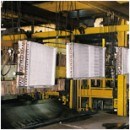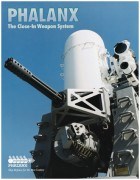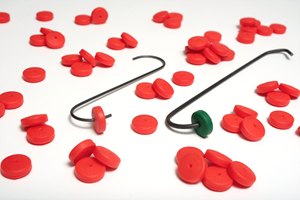AST Combats Corrosion
Corrosion costs the U.S. millions of dollars; AST has the solutions...
Metal corrosion costs the United States almost $300 billion per year (according to a recent estimate by the Battelle Institute in its "Cost of Corrosion Study."). It is estimated that 40 pct of U.S. steel production goes to replacing corroded parts, and the oil industry spends more than $2 million a day because of corrosion of its underground structures. It has been estimated that $100 billion of the $300 billion annual corrosion bill could be saved with the application of existing knowledge and technology. One company with corrosion solutions is Applied Surface Technology, Inc. (AST), Louisville, Kentucky. AST's service is extended to both the manufacturer and end user of equipment that requires protection from corrosion, abrasion or a combination of both. AST helps its customers select the proper coating or lining system; substrate preparation; metal modifications; application procedures; and quality assurance testing.
Recently AST added electrocoating to its lineup of services. The manual index system, engineered by Milbank Systems, Kansas City, Missouri, was designed around existing cranes and a gas-fired convection oven. AST installed most of the system, with certain technical assistance from Milbank.
Why did AST invest in an electrocoating line when the equipment is so expensive? The majority of products finished at AST are condensers, evaporators and heat exchangers (coils) for air conditioning systems. For the past 40 years, the coating of choice for these units has been a baked phenolic coating. These coatings are solvent-borne. Application is labor intensive, and the process is not easily controlled. Also, the phenolic finishes are brittle and inconsistent, according to Mike Powell, operations manager.
"The reason we are so interested in electrocoating," noted Mr. Powell, "is that it is durable and flexible and provides tremendous adhesion to the substrate. In addition, it has very low VOC emissions. However, we do a few things differently from traditional electrocoating that allow us to coat the entire coil easily." Mr. Powell refused to divulge the secret to AST's ElectroFinTM process.
Information he would divulge was that the ElectroFin process improves corrosion protection, particularly on sharp fin edges and fin collar edges because of a unique polymer that controls the flow characteristics of the coating. It was also developed to provide film uniformity from the outside fin edges to the deepest recesses. The coating is so flexible that bent fins can be straightened without cracking or flaking, and the coating adheres to all metallic surfaces.
Although the five-stage system is set up to finish aluminum and other non-ferrous metals, ferrous metals can also be electrocoated once they are cleaned off-line. The five on-line stages for non-ferrous metals include 1) Alkaline cleaner; 2) Rinse; 3) DI rinse; 4) Cathodic epoxy electrocoat; and 5) Permeate post rinse.
| Large HVAC coil units poised above the electrocoating tank. |
Most of the parts AST electrocoats are aluminum coils used in heating, ventilation and air conditioning units (HVAC). These range in size from small units weighing approximately two lbs to units weighing up to 5,000 lbs. The system is set up for coating a variety of parts simultaneously. "We can effectively coat low volumes and heavier parts," noted Dave McEwan, president. The 6,000-gallon tanks accommodate parts up to 32 inches wide, 8 ft high and 25 ft long.
These units are not simply "boxes" to be electrocoated. Each coil unit has hundreds of fins protruding from the unit. These fins, which must be coated 0.8 to 1.2 mils thick both front and back, add up to large surface area. One coil unit may have 25,000 sq ft of surface to coat. "We have electrocoated millions of square feet since we started up the electrocoating line a year and a half ago," stated Mike Powell.
| Smaller coil units on the electroplating line. |
The paint is specially formulated to provide the ultimate corrosion and chemical resistance. The bath also runs through an ultrafiltration system. The closed-loop system separates the paint and permeate. Permeate is stored, filtered and returned to the permeate rinse tank.
One challenge electrocoaters often face is bacteria in the DI rinse tank. AST developed the technology to eliminate it. The Bio-Cat Bio-Film cleaner is a non-bacterial, multi-enzymatic product for removing biofilms, including "green slime bacteria" and grease. Tanks are drained, and the cleaner is applied. It digests and emulsifies the biofilm and inhibits bacterial growth. Using a commercial pressure cleaning system, tanks are rinsed using 90F water. The cleaner and "green slime" are rinsed down the drain. AST now cleans its DI tanks monthly with biofilm cleaner to assure no return of bacteria.
The electrocoating operation at AST is new; however, the company has been in business for 34 years. It started as a metal fabrication shop, Liberty Plastics and Metal Co. Soon the company began spraying plastisol coatings on its tools. It found the coating business to be more profitable and changed its name to Liberty Protective Coatings. From plastisol coatings the company expanded into the application of special coatings and linings for corrosion and abrasion resistance. Applications included process piping and storage tanks for the chemical and petrochemical industries; ductwork, scrubbers and clarifiers for the pulp and paper industry; and sewer lift stations, sludge thickener tanks and pumps for municipalities. This is only a brief list of the company's capabilities. It also provides waterblasting up to 36,000 psi; waste management; waste transportation; and remediation.
AST also has the skills to breakdown big pieces of equipment, coat them and reassemble them. It dismantles complete air handlers, fans and other systems, coats the parts as specified, reassembles and ships them to the end user.
| Table I—Product Comparison | ||
| Electro-Fin™ | Baked Phenolic | |
| Color | Black | Brown |
| Salt Spray Resistance | 3000 Hours | 3000 Hours |
| Durability | Very flexible, consistent film | Very brittle, inconsistent film |
| Heat Transfer Reduction | Less than 1% | 2 - 5% |
| Fin Coverage | 100% Guaranteed | Inconsistent |
| Bridging | 0% Guaranteed | Limited to 14 fins per inch |
| Coating of Enhanced Fin Design | 100% Guaranteed | Bridging |
| pH Range | 3 - 12 | 3 - 8 |
Perhaps the foremost example of this is its work with the Phalanx close-in weapon system. The Phalanx CIWS is a high-fire-rate weapon system that automatically acquires, tracks and destroys enemy threats that have penetrated all of a ship's other defenses.
AST receives the weapon for coating and parts refurbishment from Raytheon in Louisville. All parts are returned to an "as new" surface finish and then spray coated with an epoxy primer and urethane topcoat using ITW DeVilbiss equipment. Once coated, dismantled parts are reassembled by Raytheon. The magnitude and complexity of the system cannot be overstated. AST prides itself on its ability to handle exacting jobs with precision and finesse.
| Table II—Properties | ||
| Color | — | Black |
| Dry Film Thickness | — | 0.8 - 1.2 mils |
| Gloss - 60o | ASTM D523-89 | 65 - 90% |
| Pencil Hardness | ASTM D3363-92A | 2H minimum |
| Cross Hatch Adhesion | ASTM D3359-93 | 4B - 5B |
| Impact Resistance | ASTM D2794-93 | 160 inch/lbs direct |
| Salt Spray | ASTM B117-90 | 3000+ hours |
| Humidity | ASTM D2247-92 | >1000 hours minimum |
| Water Immersion | ASTM D870-92 | >250 hours minimum |
The company is founded on the principle that protective coatings and linings are essential for many types of equipment. Therefore, AST carefully selects the proper materials to increase the equipment's life. This is the reason it chose to install an electrocoating system at its facility. Electrocoating provides a highly corrosion resistant, flexible, uniform coating on HVAC coils, which results in higher energy efficiencies and lower cost.
Related Content
Coatings Plant Evolves with Market Trends
Expanding its focus from exclusively serving the RV industry, one of this company’s stand-alone coatings plant has successfully extended its services to additional markets.
Read MoreInstalling an Ecoat Line
Thinking of investing in electrocoating capabilities? George Lovell, coatings plant manager for Lippert, discusses considerations you should keep in mind as you add your ecoat line.
Read MoreCFS Unveils New Hook Locks Parts Racking Solution
New product from Custom Fabricating & Supplies (CFS) prevents part loss during coating processes.
Read MoreTake Full Advantage of Industry Events
As travel plans ramp up for the year, what industry events will you attend? Products Finishing offers a quick look at some of the upcoming opportunities for 2024.
Read MoreRead Next
Episode 45: An Interview with Chandler Mancuso, MacDermid Envio Solutions
Chandler Mancuso, technical director with MacDermid Envio discusses updating your wastewater treatment system and implementing materials recycling solutions to increase efficiencies, control costs and reduce environmental impact.
Read MoreDelivering Increased Benefits to Greenhouse Films
Baystar's Borstar technology is helping customers deliver better, more reliable production methods to greenhouse agriculture.
Read MoreA ‘Clean’ Agenda Offers Unique Presentations in Chicago
The 2024 Parts Cleaning Conference, co-located with the International Manufacturing Technology Show, includes presentations by several speakers who are new to the conference and topics that have not been covered in past editions of this event.
Read More













.jpg;maxWidth=300;quality=90)










